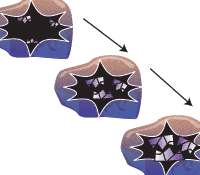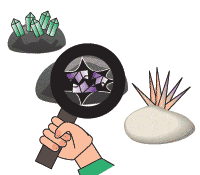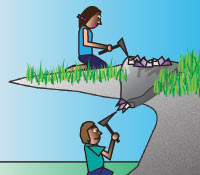Fieldwork - 8 Fun Tips to Being a Rockhound - Part 2

5. Remembering Where you found your Specimens and Cleaning Them
After having studied your treasures, it's a great idea to write down the location of where you found it, in case you or someone else wants to go back there.
Here are some steps for labeling and recording of your rocks and crystals:
- Create a number for the sample, with your initials, date and locality code in a notebook
- Mark that number on the sample, on a piece of masking tape, or a marked plastic sample bag containing the rock.
- In the notebook also record the time, location and basic description of the sample.
- Create a card that can be displayed with the Rock or Mineral.
Once home then you can also begin to clean your specimens. Remove excess rock carefully with an old penknife or dental tool pick. An old tooth brush with soapy water is great for scrubbing off mud. However be careful not to use anything abrasive that might damage the mineral and make sure the sample does not crumble when wet. Then let the crystal dry in a well ventilated area. Also spend some time to discover how the crystal should be stored so it can be enjoyed for years to come. (Back to top)

6. Knowing How the Minerals form
Often knowing where and how minerals form can be an important part of your adventure. Some minerals can only be found in certain locations because of their environment. Some minerals will only appear on certain types of rock. For instance there is a good chance that diamonds are present, if a rock called Kimberlite is in the surrounding area.
Also in order for a crystal or mineral to grow, certain forces or environments need to be present:
- They need room to grow to a large size
- The chemical, physical and temperature conditions need to be perfect
- The reaction needs to be sudden to start the process
- If the reaction stops it may stop growing or dissolve again
Rocks where crystals or minerals form often have cavities, These are created by weathering, earthquakes (causing faults and folding), gas bubbles while the rock was forming from volcanic processes or where a softer part of the rock was removed.
Sometimes minerals and crystals will run like veins through a rock wall. The mineral may have hardened in this location or softer material may once have been in these veins and then later other crystals took their places.(Back to top)

7. Knowing What Rocks to Look at
As mentioned the rocks on which crystals and minerals are found can be different and in a variety of locations. (See Know Your Crystal Shapes).
Also speaking with a geologist at your local Survey Branch is important. (Back to top)

8. Safety Tips - Not ending up in the Hospital
Even though hunting for earth's treasures can be fun it can also be dangerous if you are not observing your surrounding or are not prepared.
Here are some rules for keeping safe around mine sites, caves, quarries, and gravel pits:
- Look for and avoid hidden holes, or unstable areas around cliffs or abandoned areas
- Be aware that underground tunnels can contain poisonous gas
- Wear a hardhat in unstable rock areas
- Always look up. Could your hammering cause loose rocks to fall from above?
- Never stand below or above another person on a loose slope.
- Make sure your pick axe hammer is not damaged. Make sure its head is secure on the handle.
- Hammer away from yourself and others
- When hammering wear safety glasses
- Always tell someone where you are planning to explore and collect with a friend.
- Never Trespass on private property, always ask permission first and respect the owner’s wishes. If you’re not sure ask first.
- Carry a safety kit and learn what to do when someone is hurt.
- Before going on an adventure to a certain area, it's important to talk to someone who has already been there and ask them about the area first to avoid getting lost.
If you are exploring and you do get lost:
- Use your map and GPS System to look for geographical features (ridges, creeks, rivers) which could take you in the right direction.
- As you hike, observe areas you have passed, a fallen tree, rock or creek, and keep a mental note of where they are.
- Trust your compass, but be aware that if there is a large amount of iron metal in the ground or magnetic fields this could affect your course.
- Avoid getting wet unnecessarily.
In all cases, know how to react to the wild animals you may encounter. Carry your emergency gear, dress appropriately, check the weather forecast and allow yourself enough daylight time for your adventure. If you follow these guidelines you will have a great time!(Back to top)
